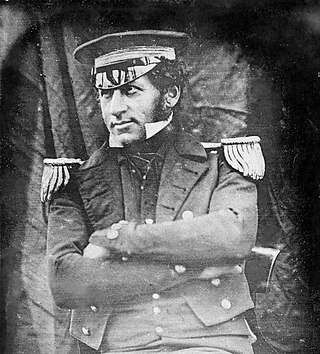
HMS Beagle was a Cherokee-class 10-gun brig-sloop of the Royal Navy, one of more than 100 ships of this class. The vessel, constructed at a cost of £7,803, was launched on 11 May 1820 from the Woolwich Dockyard on the River Thames. Later reports say the ship took part in celebrations of the coronation of King George IV of the United Kingdom, passing through the old London Bridge, and was the first rigged man-of-war afloat upriver of the bridge. There was no immediate need for Beagle, so she "lay in ordinary", moored afloat but without masts or rigging. She was then adapted as a survey barque and took part in three survey expeditions.

Admiral John Lort Stokes was a Royal Navy officer who served onboard HMS Beagle for almost eighteen years.

Nightcliff is a northern suburb of the city of Darwin, Northern Territory, Australia.

Yampi Sound is a part of the Indian Ocean off the coast of north-western Australia, in the Kimberley region of Western Australia. It is located between King Sound and Collier Bay. It lies between the Yampi Peninsula and the islands of the Buccaneer Archipelago, which contain important iron ore deposits.

Record Hill is the highest hill on North Island in the Houtman Abrolhos. It is located in the southwest of the island; its gazetted location is 28°18′19″S113°35′29″E, but in fact it is located about 150 metres north of there at 28°18′15″S113°35′29″E. It is about 13 metres (42 ft) high.

Fish Point is a point in the north-eastern corner of East Wallabi Island in the Houtman Abrolhos island chain off the coast of Western Australia. It is located at 28°25′40″S113°44′34″E. It sits at the foot of Flag Hill, the highest peak on East Wallabi Island, and its western edge looks out onto Turtle Bay.

The Abrolhos painted buttonquail is a subspecies of the painted buttonquail endemic to the Houtman Abrolhos. It is common on North Island, and also occurs on other islands of the Wallabi Group, namely East Wallabi, West Wallabi, Seagull and Pigeon Islands.

Turtle Dove Shoal is a dangerous shoal about three kilometres wide, located at 29°25′S114°12′E, in the Indian Ocean about fifty kilometres south of the Houtman Abrolhos, off the coast of Western Australia.
Batavia Road is an anchorage, or roadstead, in the Pelsaert Group of the Houtman Abrolhos, off the coast of Western Australia. It is located at 28°58′S113°58′E, on the eastern side of Pelsaert Island, near its southern end. It was discovered and named in April 1840 by John Clements Wickham, captain of HMS Beagle. Wickham's assistant John Lort Stokes later wrote:
"On the south west point of the island the beams of a large vessel were discovered, and as the crew of the Zeewyk, lost in 1728 [sic], reported having seen the wreck of a ship on this part, there is little doubt that the remains were those of the Batavia, Commodore Pelsart, lost in 1627. We in consequence named our temporary anchorage Batavia Road, and the whole group Pelsart Group."

The Cherokee class was a class of brig-sloops of the Royal Navy, mounting ten guns. Brig-sloops were sloops-of-war with two masts rather than the three masts of ship sloops. Orders for 115 vessels were placed, including five which were cancelled and six for which the orders were replaced by ones for equivalent steam-powered paddle vessels.
Flag Hill is the highest hill on East Wallabi Island, and the highest point in the Houtman Abrolhos, an archipelago off the coast of Western Australia. It is located in the north-east of the island; its gazetted location is 28°26′7″S113°44′14″E, but in fact it is located somewhat east of there at about 28°26′02″S113°44′18″E. It is about 15 metres (50 ft) high.
Lort River is a river located in the Goldfields-Esperance region and the Eastern Mallee sub-region of Western Australia.
Stokes Inlet is an inlet in the Goldfields-Esperance region of Western Australia.
Champion Bay is a coastal feature north of Geraldton, Western Australia, facing the port and city between Point Moore and Bluff Point.

The era of European and American voyages of scientific exploration followed the Age of Discovery and were inspired by a new confidence in science and reason that arose in the Age of Enlightenment. Maritime expeditions in the Age of Discovery were a means of expanding colonial empires, establishing new trade routes and extending diplomatic and trade relations to new territories, but with the Enlightenment scientific curiosity became a new motive for exploration to add to the commercial and political ambitions of the past. See also List of Arctic expeditions and List of Antarctic expeditions.
Pringle Stokes was a British naval officer who served in HMS Owen Glendower on a voyage around Cape Horn to the Pacific coast of South America, and on the West African coast fighting the slave trade. He then commanded HMS Beagle on its first voyage of exploration in the south Atlantic. After two years in command of the Beagle, depressed by the harsh winter conditions of the Strait of Magellan, he committed suicide.
H.M. Colonial Schooner Champion was in service with the Colony of Western Australia from 1836 until 1852.

Graham Gore was an English officer of the Royal Navy and polar explorer who participated in two expeditions to the Arctic and a survey of the coastline of Australia aboard HMS Beagle. In 1845 he served under Sir John Franklin as First Lieutenant on the Erebus during the Franklin expedition to discover the Northwest Passage, which ended with the loss of all 129 officers and crewmen in mysterious circumstances.












